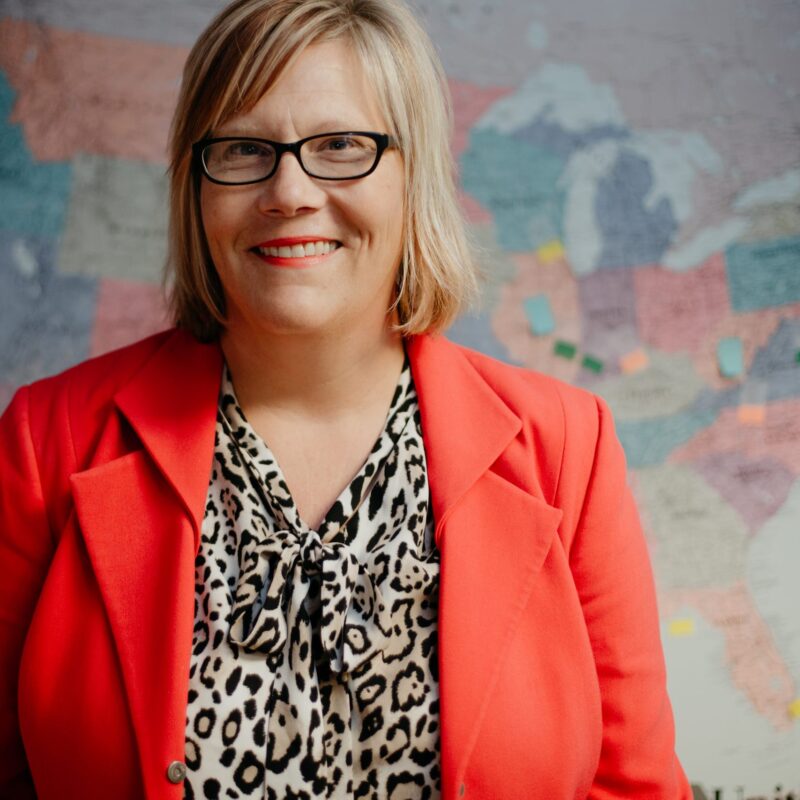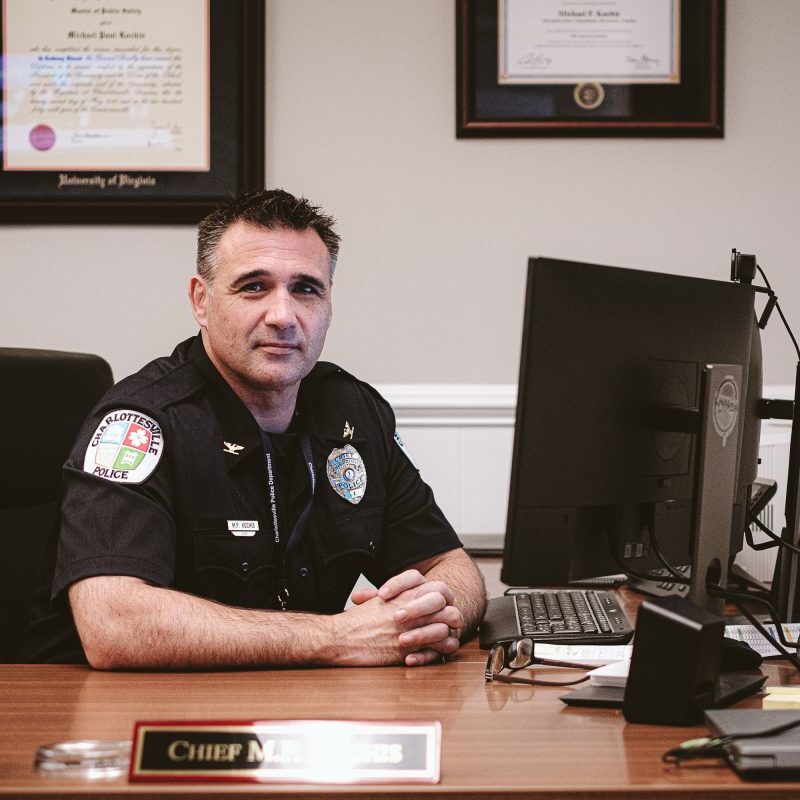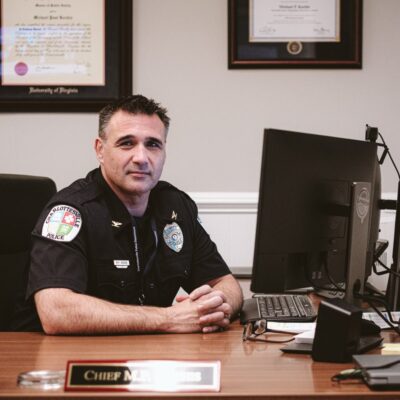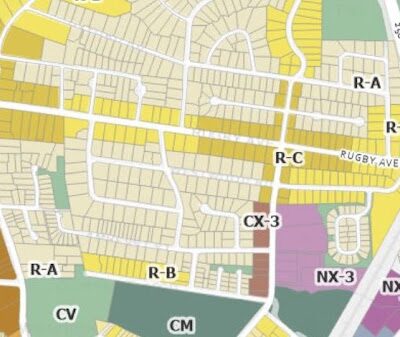Mark Higgins’ Mystery Machine is a white Chevy Trailblazer with a “Ghost Hunter” license plate holder, but we’re not blazing trails or hunting ghosts yet. Instead, we’re stuck 10 miles from Pantops Mountain on Route 231, a two-lane road that leads to Gordonsville and to one of the most “active” sites Higgins has investigated: the Exchange Hotel, a former Civil War hospital.
| Listen for yourself! Do you hear ghosts?
Sounds before "All right" |
The line of stopped cars extends beyond a bend in the road, so we can’t see the cause of the hold-up. While we wait, we make small talk. Higgins says that paranormal is “a big hot topic right now—it’s all over the news, and there are new shows popping up on cable all the time.” I show Higgins my copy of Dennis Hauck’s Haunted Places directory, and tell him that the trailer for Paranormal Activity 2, the sequel to a 2009 horror film that banked more than $100 million domestically, was pulled from some theaters after it terrified a few Twilight fans.
Higgins hasn’t seen Twilight, but says he liked The Sixth Sense—a movie about a boy who constantly sees dead people around him. Except…
“People who have visions and can see dead people? I’m a little skeptical about that, a little bit on the fence about that,” says Higgins. He adds that he’s seen “strange stuff” during investigations, including what he calls “shadow figures,” but never a dead person.
We’re nearing the bend in the road, but still can’t see the source of the delay. After a few more minutes, Higgins calls ahead to our tour guide, Tim Burnett, president of Historic Gordonsville, Inc., to let him know we may arrive later than planned.
“You know, I don’t believe in coincidence anymore,” says Higgins when he hangs up. “I really don’t.” Cars ahead of us start to turn away from Gordonsville and what waits beyond the bend, and the Mystery Machine lurches slowly forward.
|
The Exchange Hotel in Gordonsville is the last Civil War-era receiving hospital standing in Virginia. More than 70,000 soldiers passed through the space; of those who died, more than 700 were buried on-site. |
After 45 minutes, we finally see the accident. A tan car sits in the lane opposite ours, with its nose caved in and its insides empty. And as we pass—call it a coincidence, if you believe in that sort of thing—the song playing on Higgins’ radio is Billy Ocean’s No. 1 single, “Get Outta My Dreams, Get Into My Car.”
Higgins turns his head towards me—his large, St. Bernard eyes peer from beneath his black cap—then towards Robin Macklin, my photographer. “Do you guys believe in coincidences?” he asks.
Twenty-four hours after the Washington Post published a feature story about a group called DC Metro Area Ghost Hunters, I received my first e-mail from Higgins—a letter about his own group, Spirit Search Paranormal Investigators. A film crew for A&E Biography’s “My Ghost Story” TV show [see box for show time] had visited Higgins and filmed a segment about SSPI’s work at the Exchange Hotel. Was I interested in visiting the spot? Coincidentally, yes, I was.
As we pass the car accident, the photographer turns and tries to take a photo of the wreck, but can’t snap one in time. The Mystery Machine rolls on towards Gordonsville.
“I think these roadblocks and ‘Why is this happening now?’-type moments have some deeper meaning,” says Higgins. “I believe they were meant to happen, I really do.”
When there’s something strange in the neighborhood…
Higgins, 46, works as a sales executive in Charlottesville. His father was an Army intelligence officer, so the Higgins family moved frequently. After Higgins finished high school in Germany and enrolled in at the University of Munich, his father was reassigned to a position with the Judge Advocate General’s (JAG) Corps in Virginia. Higgins graduated from Longwood in 1986, bought a townhouse in Pen Park four years later, and has lived with his wife and family near the Downtown Mall since 2003. He has never investigated his own home.
A few years ago, Higgins says he experienced “a paranormal event” that he declines on multiple occasions to elaborate on. (“It was powerful,” he writes in an e-mail, “and has had a lasting effect on me to this day.”) He founded SSPI in 2006 to “help others better understand what may be happening to them.”
|
“It takes a lot of time and dedication when reviewing audio and video from an investigation. There are many people who simply don’t want to take the time required to discover possible evidence,” says Mark Higgins, founder of Spirit Search, in an e-mail. “Some investigations are long and boring where nothing happens. Then all the sudden something crazy happens and you have one of those, ‘Wow, what was that?’ moments. If you go into an investigation just to say you saw a ghost, then you are in it for the wrong reasons.” |
SSPI keeps its team of investigators small and its tools minimal. Higgins met his audio specialist, Chris, in a paranormal group called CASPER. (Chris asks that I identify him by first name only.) Higgins had already founded SSPI, and offered to investigate Chris’ home. After the two found they shared interests and their work complemented one another—the trailblazer and the technician—Chris joined SSPI.
When the pair investigates a site, they bring along a few cameras, a pair of digital audio recorders and a K2 meter—which, if you haven’t seen it on TV shows like “Ghost Hunters,” resembles a TV remote control topped by a row of colored lights. The K2 meter measures variances in electromagnetic fields; Higgins brought his K2 meter by my office one day to show me how it worked, and registered 20 milligauss units in our office—a high reading. At the time, Higgins seemed less interested in hauntings and more concerned for my health.
The website for Spirit Search hosts selected case files for the group’s investigations, many tagged as “Private Residence” or “Private Business” and numbering into the 70s. SSPI’s services are billed as “free of charge,” and Higgins says he has “never made a dollar” off of his research.
The website also offers a testimonial from Robert Kocovsky, a former general manager of the Exchange Hotel, who writes: “Mark’s methodology and his uncanny intuition were key factors in discovering what ethereal [sic] existences that are still active at the Exchange.”
Marty Seibel, director of the Shenandoah Valley Paranormal Society (SVPS) in Staunton, also vouches for Higgins’ work. SVPS joined SSPI for two investigations of the Exchange Hotel—“an awesome place to investigate,” according to Seibel.
“I think he’s very rational-thinking,” says Seibel of Higgins. “I think he has some top-notch people in his group.”
And with more than 20 investigations and hundreds of audio recordings, if SSPI has a single haunted place to call its own, it’s the Exchange Hotel.
Gathering evidence
The Exchange Hotel was built in 1860, and sits at the intersection of two railroad lines—the Chesapeake and Ohio (C&O) and the Orange and Alexandria (O&A). During the Civil War, the hotel became the Gordonsville Receiving Hospital, where doctors performed what Tim Burnett, president of Historic Gordonsville, Inc., calls “meatball surgery.” Of the 70,000 soldiers, Union and Confederate, treated at the hospital, about 900 died there; of the dead, more than 700 were buried at the site, and later reinterred elsewhere.
Historic Gordonsville, Inc. acquired the property from C&O Railroad in 1971 and spent the better part of two decades renovating the structure—a three-level Georgian building with a central stairwell that functions as the hotel’s spine. The Civil War Museum at the Exchange Hotel opened in 1989, and offers tours six days a week, from April through mid-November. For a couple days in October, the Exchange Hotel offers ghost walks for the $4 to $6 admission price. Burnett estimates between 2,500 and 3,000 visitors each year, and $40,000 in revenue.
When we arrive, Higgins introduces Burnett, who greets us with a toothpick in his mouth and a cigar in his breast pocket. A tour of the 3,500-square-foot hotel typically takes 90 minutes, but Burnett promises to make short work of the first floors so we can spend time in some of the house’s “active” spots.
 |
As Burnett talks about the hotel’s history, I hear a dog bark, but can’t spot the animal. My mind briefly asks: Ghost dog? A moment later, a Burnett’s collie, Princess Gracie, appears. She satisfies her curiosity by sniffing us, then leaves with Burnett’s wife as we head towards the front door.
During his investigations, Higgins and his audio specialist, Chris, say they’ve recorded hundreds of what ghost hunters widely call Electronic Voice Phenomena (EVP). A two-hour SSPI investigation at the Exchange might turn up more than 100 EVPs.
“The audio files, in my opinion, are the hardest to discount, the hardest for skeptics to say, ‘O.K., I know what that is,’” says Higgins. I ask Higgins if EVPs can only be found inside a structure.
MARK: No, you can get them outside, you can get them anywhere.
ME: So, hypothetically, I could be getting something.
MARK: You could be getting something on that. It wouldn’t surprise me.
Before we step into the hotel, I turn my tape recorder on and leave it running. Higgins tells me that he may act strange if he senses anything in the hotel, and I don’t press him on what, exactly, he means.
Burnett leads us through what was once the hotel pub, tucked beneath the broad staircase that leads to the building’s second-floor main entrance. He points out a wooden water pump once used by Stonewall Jackson. Suddenly, Higgins’ eyes grow wide. His shoulders tense, and I wait for a sudden sound or motion from him. A second later, he removes his vibrating cell phone from his pocket. No ghost messages; just text messages.
We move on to the hotel’s main level, and walk across 150-year-old heart pine floors through a parlor with a piano and brass candlesticks that chime with our motion. Burnett tells us he once felt “something cold” pass through him at a doorway. It was eight years ago, he remembers, “because I was still with my ex-wife.” He shows us a room with the largest collection of Confederate uniforms from a single officer, and then a smaller space devoted to the Union. “No reason to spend a lot of time here,” says Burnett, and so we don’t.
After a stop in the “mourning room”—the funeral parlor, a space where the living once adjusted to the presence of the dead—we arrive at the staircase to the third and final floor.
Along with the kitchen building, the top floor of the Exchange Hotel is what Higgins calls the “most active” portion of the site. As we ascend the stairs, Higgins and Burnett share stories: Gordonsville police spotted a lantern one night through a window, and Burnett’s son heard a door slam shut in an empty room. Prior to our tour, Higgins sent me photos of the staircase that depict what he calls a “green mist” in multiple shots.
“Of all the times I’ve been out here, for me personally, it’s this upper area that starts to get interesting,” says Higgins.
After we walk through a bedroom where Higgins says his digital camera once inexplicably failed to focus, we enter the surgery room. A glass display case along one wall features a blood transfusion kit that looks like a bicycle pump, and a drilling kit for relieving cranial pressure. I ask Burnett about a series of long, slender poles inside the case. Urethra expanders, he explains.
|
The University of Virginia’s Division of Perceptual Studies is one of the few research centers devoted to documenting paranormal events, from past-life memories to deathbed visions. Dr. Jim Tucker, an assistant professor at the division, said during a recent presentation that “there are no other centers studying these cases.” |
Before we leave, Higgins and Burnett show us the exchange depot and the kitchen building. The latter, says Higgins, is one of the site’s most active spots for EVPs; during one investigation, Higgins and Chris counted 76 different phenomena in a room at the top of the kitchen.
Burnett bids us farewell and the photographer leads Higgins to the hotel to take a few photos. Meanwhile, I sit down on the front step of the kitchen, start my tape recorder, and try to talk to ghosts. “Normal or paranormal,” I say to my tape recorder. “Ghost or otherwise.” After three minutes, I turn my tape recorder off, climb into the Mystery Machine, and head back to Charlottesville. The drive is uneventful and, when we pass by the accident site, the wrecked car is gone.
Paranormal Charlottesville
In 2007, the year that Higgins and Chris first stepped into the Exchange Hotel, 88-year-old Ian Stevenson died of pneumonia. Forty years prior, Stevenson—perhaps Charlottesville’s original paranormal investigator, certainly the best-known—founded UVA’s Division of Perceptual Studies (DOPS, and originally called the Division of Personality Studies), where he and colleagues documented and studied reports of past lives and visions.
When he died, Stevenson left behind a database of more than 1,000 cases of past-life recollections, along with a test to see whether communication with the afterlife was possible. In his New York Times obituary, Stevenson is said to have set a combination lock 40 years before his death, according to “a secret mnemonic device—a particular word or a sentence, perhaps—known only to him.”
If possible, Stevenson would try to communicate the phrase or message that would open the lock. However, Stevenson’s colleague Dr. Emily Kelly, who researches deathbed visions and crisis apparitions, told the Times during the week of his death that the combination had not been cracked.
Unlocking the DOPS proved just as difficult. I requested interviews with multiple researchers in the Department of Perceptual Studies, but all politely declined. On July 21, I spoke with the DOPS librarian, Lori Derr, who agreed to let me visit the department’s collection of books.
“It is not a circulating library, meaning that you cannot check anything out,” wrote Derr in an e-mail. “But I can let you in the library for a while to do your own research.”
The next day, however, the invitation was retracted.
“The press has trivialized our work here at DOPS in the past for entertainment purposes and we are very wary of this sort of thing happening,” wrote Derr, who directed me to an online archive of articles instead.
I did, however, attend a lecture at the Rutherford Institute by Dr. Jim Tucker, research director of DOPS. The talk, titled “Life Before Life: Does Consciousness Survive Death?” detailed DOPS studies of children who recall past lives. In one case, a young girl named Punima tells her family she was once an incense manufacturer named Jinadasa, and recalled the scents she once sold. In another, a 20-year-old girl dies of a congenital heart defect and is painted in lipstick marks by her friends; years later, her sister gave birth to a girl with similar markings.
“When I read this book [Life Before Life], it changed my mind on the subject,” said Rutherford founder John Whitehead. “That’s why he’s here today.”
In a previous interview with Whitehead, Tucker said, “There is no reason that unusual phenomena or paranormal phenomena can’t be studied with the same sort of scientific approach that you would use to study any other phenomenon.” Research by the DOPS “contribute[s] to evidence that there may be life that survives the death of the body. To me, that is more interesting than the particulars.”
Do all investigations begin as paranormal investigations? When a group like Spirit Search—or, for that matter, the Department of Perceptual Studies—makes private work public, there is a natural sort of resistance, a tension of the unknown versus the known. Higgins’ audio specialist, Chris, likes to tell a story about Nicola Tesla, the inventor who once claimed to intercept radio signals from Venus. Tucker told Whitehead in a previous interview that “there are certainly some colleagues who are quite supportive and others who just turn their noses up at us.”
During one of our conversations, I ask Higgins whether he considers himself a skeptic. He says no.
“I can’t tell you 100 percent what’s going on. All I can tell you is, what I do doesn’t make any sense when I get some of these recordings of voices,” says Higgins. “And I’m still trying to figure out what it could mean. It’s one of those things you wrestle with.”
Hearing voices
A few weeks after Higgins and Burnett led me through the Exchange Hotel, I drive back to Gordonsville to visit Chris, the audio specialist. I bring my notebook and the three minutes of ghost interview I recorded on the front step of the Exchange’s kitchen.
Chris lives a half-mile from the hotel, in a rented house built nine years before the Exchange opened its doors to guests. I’d visited Chris once before, so he could play me a selection of EVPs from previous Spirit Search investigations—audio files with names like “Freedman,” “Get out” and “Hi—get over here.” To identify EVPs, Chris uses audio software to amplify high frequencies and diminish low ones.
During the same visit, Chris explained that he works as a “troubleshooter” for the State Department: When a U.S. embassy experiences power failures, he travels to the embassy to track its power usage for 48 hours and diagnose the origin of the problem. Perhaps sensing my skepticism, he passed me a watermarked State Department I.D.
When I arrive, Chris brings me through his living room to the dark, wooden table that dominates his dining room. He asks me where I recorded my audio, how long the digital file is, whether I noticed anything odd when I listened to the recording, whether I accidentally tapped my microphone with a finger or ring, or picked up a nearby voice.
“The hardest thing,” says Chris of reviewing hours of EVPs, “is remembering if someone was there, stomach growls or ambient noises present when recorded.”
We spend more than a half-hour on my three minutes of tape. Frequencies over 800Hz are boosted, and those 200Hz and below are lowered. We listen, adjust the frequencies, try to ignore birds that I recorded weeks before but don’t recall seeing. I listen to myself talking to myself and think, If nothing answers, this guy will think I’m nuts. If something does answer, I wonder if I’ll think the same.
Occasionally, the audio file emits a few seconds of clicks and pops, or smacking and sucking sounds, like someone biting a plum. Seven minutes into our listening, I hear my recorded voice ask for some comment: “Normal or paranormal…ghost or otherwise.”
Chris presses “PAUSE.”
“Did you hear that?” And, when he replays it, I do. And more clearly the second time —a few syllables, three or four. He tells me he hears something, and asks if I do. I tell him yes, I think so, but want to avoid being led to a conclusion.
I tear a sheet of paper, hand half to Chris, and we write down what our minds made of a few syllables. I place my paper down: “I don’t like you.” He follows suit: “I’m pretty.”
“Now, your mind is not creating this sound. Your mind is interpreting this sound,” says Chris. “And I know you say, ‘Well, that’s the same thing.’ Well, not necessarily.”
To some degree, Chris is right. After we listen a few more times, I realize the sound is three syllables, not four; it sounds closer to “I’m pretty.” So, while neither of us can explain the sound, our minds now wrestle with the same phrase—which neither of us can prove exists, anyways.
“I think it’s psychological,” says Chris. I ask him what he means.
“Were you that earnest? Were you open?” asks Chris. “Did you believe yourself, asking your questions in mid-air?” He adds that, if ghosts never talked to me before, why would they start now?
“I tell people it’s like driving down the interstate,” Chris continues. “You pull over to the side of the road and you’re trying to get everybody’s attention in busy rush hour. Unless there’s some common denominator…they’re not going to give you the time of day, they’re not going speak to you.”
When I leave Chris’ home, I drive south through Downtown Gordonsville on Route 231. Ten miles down the road, I pass the spot where, weeks earlier, a crumpled tan car stopped traffic for nearly an hour. Other cars turned around before they saw the wreck, and I don’t have a picture to prove it happened, but I’m telling you that it did. Still, do you believe everything you hear?








